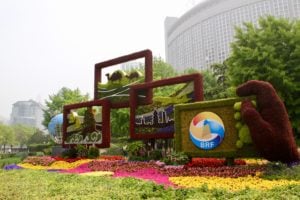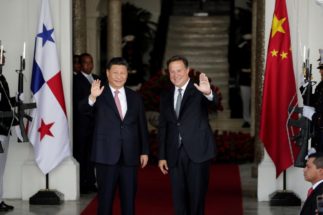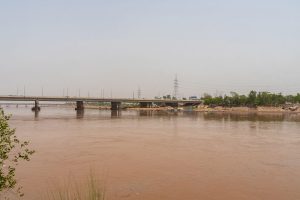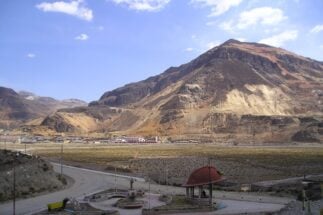Speaking at Panama’s Ministry of Foreign Affairs on August 17, US national security advisor Robert O’Brien wrapped up his visit with a brief statement: “True friends are there for each other when times get tough…thanks to China, unfortunately, these days are very tough.”
O’Brien used his visit to promote the delivery of 50 US-made ventilators, the promise of FBI support in anti-money laundering operations and a memorandum of understanding to deepen cooperation on infrastructure projects through the US’s América Crece (Growth in the Americas) programme.
His somewhat needless and jarring reference to China on what was essentially an aid visit did little to disabuse the notion that América Crece is a response to the growing number of Latin American countries signing up to the Belt & Road Initiative (BRI), the infrastructure plan promoted by the US’ geopolitical rival.
The US has succeeded in getting 14 countries across the region to sign up to América Crece so far, compared to the BRI’s 19. So what does it offer? And do countries in need of development finance have to choose between one or the other?
What is América Crece?
While BRI has become highly visible in the media, few details about América Crece – the expanded version of which was launched in December 2019 – exist beyond a jargon-filled online FAQ. It proposes a “whole-of-government approach” to help Latin American nations access private investment for energy, road, ports and airport projects.
$60 billion
The new lending budget of USAID's Development Finance Corporation
No additional funding is available for this vital infrastructure. Rather, it will “leverage existing programs [and] diplomatic engagement”, the FAQ says. That said, one supporting institution is the newly-created Development Finance Corporation (DFC), part of the United States Agency for International Development (USAID), which has boosted limits for overseas investment of US$60 billion compared to the US$29 billion of its previous incarnation the Overseas Private Investment Corporation (OPIC), US analysts note.
The programme does offer to help countries “improve their regulatory frameworks and procurement structures”, a pledge that can be seen to address criticism from some US scholars and Latin American NGOs that the award of energy and mining projects to Chinese companies in Venezuela, Ecuador and Argentina have been opaque.
“América Crece is not about competing with Chinese state-owned companies to build infrastructure,” says R. Evan Ellis, professor of Latin American Studies at the US Army War College Studies Strategic Studies Institute. “The US wants to leverage private sector investment to bring prosperity and – through transparency and good governance – show that it is a better, more sustainable option for the region than China’s sometimes predatory practices.”
However, while the BRI promises – on paper at least – to promote ‘green development’, references to sustainability in América Crece policy documents refer to transparent processes and competitive financing, although some experts say investments would naturally adhere to higher social and environmental standards. So far, like the BRI, major loans from América Crece have largely supported fossil fuels.
In El Salvador, the DFC has agreed to loan over US$1 billion for an integrated Liquid Natural Gas (LNG) import terminal and gas power plant and $300 million to Vista Oil and Gas, a New York Stock Exchange listed company developing shale gas projects in Argentina.
According to Evan Ellis, the programme will encourage investment from private companies around the world and “put the recipient nation’s needs first”.
“The Belt and Road program follows the Silk Road tradition: it looks to rewire the world to benefit China…América Crece isn’t designed to benefit US companies,” he claims.
Which countries have signed up?
Following Panama, O’Brien flew to Colombia, where he promised further support in infrastructure and anti-drugs projects through ‘Colombia Crece’ – reportedly to the tune of US$5 billion.
Colombian officials touted it as a follow-up to Plan Colombia, under which the governments of Bill Clinton and George Bush provided the country with millions of dollars, mainly for anti-drug operations. Funding continued under the Obama administration, although it was largely redirected to peace-building initiatives.
The Trump administration has also continued to pressure Latin American countries to cooperate with the US global policy agenda
Argentina, Bolivia, Brazil, Ecuador, Chile, Guyana, Jamaica, Suriname, Uruguay and the Northern Triangle countries (Guatemala, El Salvador and Honduras) have also signed onto the programme. Many have also endorsed the BRI, with the notable exceptions of Brazil and Argentina, which is weighing up an agreement.
Aside from Argentina, all signatories could be considered to have broadly US-friendly governments. However, as with the BRI and Chinese firms, nations not joining América Crece are unlikely to notice much difference in the level of US private investment they attract.
What do China and Latin America make of it?
While América Crece has yet to be mentioned in Chinese public media, a number of local think-tanks and academics have cast the project as a direct challenge to the BRI in Latin America, with more forthright critics labelling it “A New Monroe Doctrine”, a reference to a 19th century policy that defines Latin America as the US’s exclusive area of influence.
An August 2020 paper by Guo Yu, an assistant researcher at China’s Ministry of Commerce, forecast that América Crece would have limited concrete effects but should be seen as part of a wider strategy by the Trump administration to “form an encirclement, which is bound to affect China’s policies and future developments in Latin America and the Caribbean.”
Guo urged China to maintain “strategic determination” to pursue with the BRI in Latin America and, based on its existing Chinese Ministry of Foreign Affairs’ white papers on Latin America, improve communications and transparency with respect to its regional policy agenda.
Contrary to América Crece’s pledge to improve good governance, the initiative appears to force a partisan choice of development partner on Latin American countries, according to Sun Hongbo, an associate researcher at the Chinese Academy of Social Sciences’ Institute of Latin American Studies.
“The Trump administration has also continued to pressure Latin American countries to cooperate with the US global policy agenda, making Latin American countries face more challenges in adhering to multilateralism and participating in global economic governance reforms,” Sun wrote recently in Contemporary World, a journal under the auspices of the International Liaison Department of the Communist Party of China’s Central Committee.
In the past when US delegations brought aid delegations to Panama, they often wanted changes to Panama’s internal politics
In Panama, a proxy stage for US-China geostrategic tension by virtue of its interoceanic canal, the US diplomatic push against rapidly rising Chinese investment has been particularly pronounced. Before the pandemic, China found its trade talks frozen and its companies disqualified from tenders.
In the days after the first Panamanian Covid-19 case was detected in March, China Construction America, a subsidiary of the state-run China State Construction Engineering Corporation (Cscec), offered to convert is recently built Amador Convention centre into a hospital with 1500 beds. The offer was rejected by the government in favour of a smaller hospital that was beset by delays and allegations of corruption and only received its first patients on June 11.
“The hospital was just the most prominent example, but the Panamanian government also rejected Chinese offers of masks and other equipment but this was not made public,” says Fernando Aparicio a professor of History of International Relations at the University of Panama. “Panama decided, instead, to pay for what China offered us for free.”
Beyond imprecise pledges to assist in the development of much-needed infrastructure, implicit in América Crece is the familiar practice of forcing Latin American countries to shun US adversaries. And in Panama at least, it appears to be working.
“In the past when US delegations brought aid delegations to Panama, they often wanted changes to Panama’s internal politics,” says Aparacio. “What was discussed by Cortizo and O’Brien has not been made public, but it seems this has to do with external politics, with Panama’s relationship with China and Cuba.”








